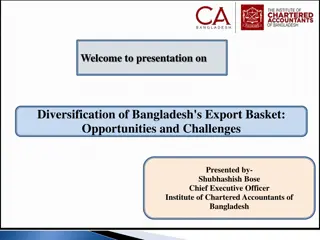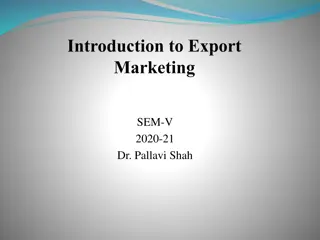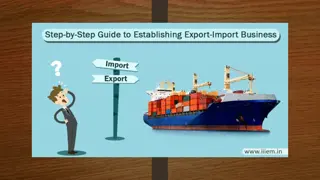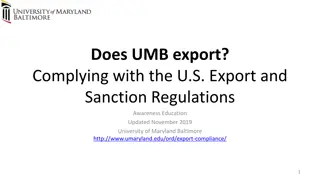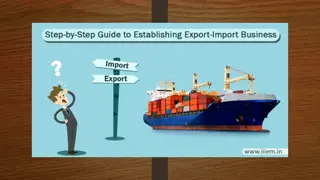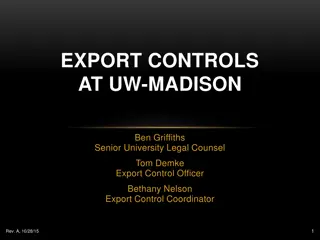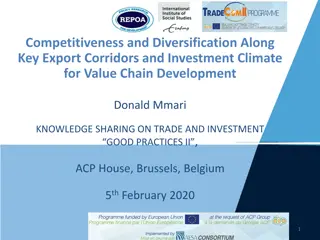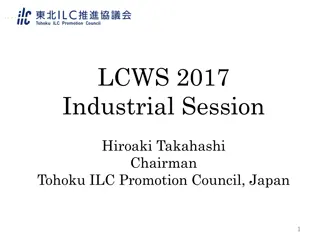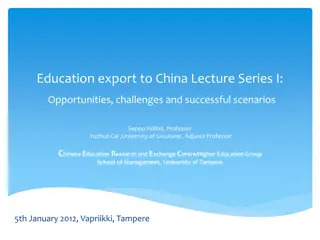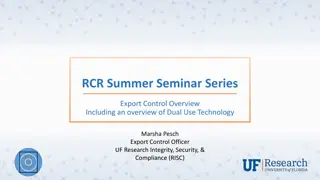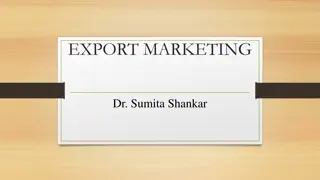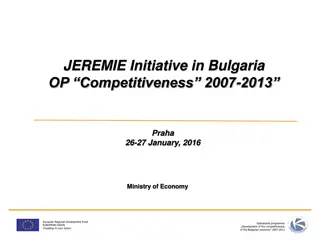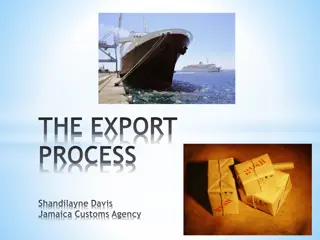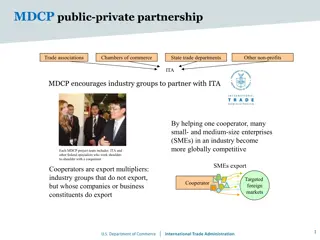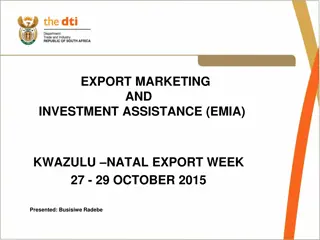Export Promotion and Investment Competitiveness in Japan and France Cases
Japan External Trade Organization (JETRO) and Business France play crucial roles in promoting exports, attracting investments, and supporting economic competitiveness in Japan and France. JETRO facilitates innovations, supports exports of agricultural products, and assists Japanese companies in overseas business endeavors, while Business France promotes investing in France with its world-class infrastructure, deep talent pool, and strategic positioning. Explore how these organizations contribute to the export-oriented investments and competitiveness of their respective countries.
Download Presentation

Please find below an Image/Link to download the presentation.
The content on the website is provided AS IS for your information and personal use only. It may not be sold, licensed, or shared on other websites without obtaining consent from the author.If you encounter any issues during the download, it is possible that the publisher has removed the file from their server.
You are allowed to download the files provided on this website for personal or commercial use, subject to the condition that they are used lawfully. All files are the property of their respective owners.
The content on the website is provided AS IS for your information and personal use only. It may not be sold, licensed, or shared on other websites without obtaining consent from the author.
E N D
Presentation Transcript
Export Promotion Export oriented Investment &Export Competitiveness Japan France cases&JETRO s60years history July 2020 H.Horiguchi,JICA advisor
Japan *Japan External Trade Organization Incorporated Administrative Agency Act (December 13, 2002, Law No. 172) *Established October 1, 2003 (Originally established in 1958) Offices Domestic: JETRO Headquarters Tokyo, JETRO Osaka, Institute of Developing Economies, JFOODO and 47 regional offices Overseas: 74 offices (54 countries) (as of November 2018) Employees 1,730people (998 domestic & 732 overseas) (as of April 2019) <Main Activities > 1.Facilitating Innovations Through Inward Foreign Direct Investment (FDI) in Japan and Supporting Overseas Expansions of Startups 2.Supporting Exports of Japanese Agricultural, Forestry, and Fishery Products and Food 3.Assisting Japanese Companies with Their Overseas Businesses 4.Contributing to the Activities and Trade Policies of Japanese Companies Through Surveys and Research Source:JETRO
The Japan Food Product Overseas Promotion Center April 2017 in JETRO Source:JETRO
France BUSINESSFRANCE *Established in 1stJAN.2015 *Merger between Ubifrance(Export Promotion) and InvestinFrance. *1,500 employees & 87 Offices In the World REASONS WHY YOU SHOULD INVEST IN FRANCE *WORLD-CLASS INFRASTRUCTURE *A LEADING AND OPEN ECONOMY *DEEP TALENT POOL *STRATEGIC POSITION *ENTREPRENEUR IS A FRENCH WORD *A LEADING FINANCIAL CENTER IN EUROPE source:BUSINESSFRANCE In France,Export promotion under the Ministry of Finance,but attracting FDI under ministry related to Land development.Overseas office mainly at the Embassies.
France:Protected Geographical Indications(PGI) Official labels of quality and origin Some data(PGI) Agro-food products 122 PGI registered in France 1.2 billion euros of turn-over Wine sector 74 PGI wines registered in France : 1/3 of French production 2 ciders registered in France Turnover in 2012 : PGI and PGI Label Rouge : 1 460 million euros PGI wines : 1 390 million euros Source:INAO (Institut national de l Origine et de la Qualite) Photo:Ministdere de l Agricuture et l Alimentation France
Japan Productivity 1.Energy saving Japan is one of the world s most energy-efficient nations Post Oil crises(1973,79) Steel Coal For example, other nations such as the US, China, Russia, and EU nations use 1 to 1.25 times more energy to produce one ton of steel Home Electric Appliances requested from consumer side strongly Energy Saving Measures. During the summer period, demanding for air conditioning rises. The peak time of 9am through 8pm.
2.Kilometer per liter <Japanese Main exportable Items in 1960> <Motor Vehicle Production in 2016> 9,204,692(production in 2016) 560,532(production in 2016) <Fuel Efficiency estimated under the FY2022 standards> Items Share(%) Texitile 30.2% Machinary (Vehicle) 25.3% (2.6% ) Metal 13.8% Chemical 4.2% FY2012 FY2022 Ratio Others 26.5% Average fuel Efficiency of Small Freight Vehicles 14.2km/l 17.9km/l 26.1% The Clean Air Act in US 1970s> Air pollution measures Fuel efficiency technology EV Lithium Ion Battery) Fuel Cell(H2O) Source:Data,METI Japan
3.SMEs Policy Small and Medium Enterprise Agency established (1948) SME Basic Act enacted (1963) Challenge of SMEs in Japan Three Lacks *A lack of a raise money:Japan Finance Corporation for Small and Medium Enterprise (1953) established *A lack of the technology:SME Modernization Promotion Act (1963) ex. public Research and Development Institute (local Gov.) ex.transfer technology from large companies *A lack of the informations:SME Association Organization Act (1957) ex.sending a mission to overseas market ex. international trade fair 1.Number of Companies:4.2million SMEs:99.7% Large enterprises:0.3% 2.Value added(manufacturing) SMEs:50.6% Large enterprises:49.5% 3.Subcontractors Vertically Supporting Industry 4.Participation in High Tech Industry horizontally NASA&Boeing,AirBus Source:Data,Small and Medium Enterprise Agency Japan
Pakistan Trade Policy Initiatives (Refer to Japan's response since the 1960s) 1. Current state of Pakistan (created from past trade policies, etc.) Securing export competitiveness: Reduction of production costs, setting tariff rates commensurate with production costs, and thorough productivity improvement. Measures to attract export type investment: Pakistan's investment attracting measures so far have basically been based on the domestic market acquisition type, and exports of industrial products are extremely limited. The /PTA is also one of the original purposes, and one party is characterized by a low idea of market development (export expansion) of the other. Moreover, low labor productivity, lack of investment attraction measures, and lack of fusion of policies for industrial promotion and export promotion can be said to be the reason why export-type investment was limited. Necessity to attract investment for export promotion Simplification of various investment procedures The import substitution investment necessary for the domestic market is strictly limited, and the focus is on export- type investment. At the time of the FTA/PTA negotiations, the negotiations will be made with the Pakistan side in mind to ensure export competitiveness. Specifically, first try to promote the utilization of the existing FTA/PTA. At the same time Considering revision of clauses to secure Stan's export competitiveness.
2. Japanese success stories The major export items of Japan in the 1960s were textiles and light industrial products, and the automobile industry, which is the current core industry, was extremely limited. However, it is well known that the industrial structure has changed drastically in 60 years. One of the reasons for this is the Basic Law for Small and Medium Enterprises in 1963, and the establishment of public laboratories based on the technology promotion of small and medium enterprises at each post-prefectural level. We believe that the technology transfer by the relationship between companies and SMEs) is also a feature. On the other hand, in the case of Japan, which lacked major resources and increased its dependence on imports, it became obligatory to maintain both the improvement of technological level and the reduction of production costs because of the national policy of becoming an export nation. First, reducing import costs can be characterized by reducing production costs through efficient use of fossil fuels (eg, efficient use of coal for iron production). This is still a Co2 reduction effect as an energy-saving technology in Japan, which lacks resources. On the other hand, for export promotion, a public export promotion organization was set up (established in 1958 by the merger of the current JETRO, overseas market research, overseas trade fairs, and agricultural and fishery exports). Thorough analysis of overseas promising markets, introduction of Japanese products to overseas promising markets (trade fairs, Expo and permanent exhibitions by JETRO overseas offices, etc.). In response to trade fairs, introduction of a wide range of items such as industrial products and agricultural products overseas. Develop a business. JETRO will also introduce export items from the industrial/agricultural/fisheries industry and local governments, and promote exports under the All Japan system. On the other hand, Japan's unique general trading company function (function to perform business cooperation between export-demanding companies and overseas companies, and also to import resources into Japan) will be strengthened through cooperation with the Ministry of International Trade and Industry and JETRO.
The current function of JETRO is due to changes in Japan's trade policy (trade friction with Europe and the United States: promotion of imports into Japan, promotion of investment in Japan in response to the revitalization of Japan's local regions in order to respond quickly to globalization, etc.). Along with this, it has undergone drastic changes, and exports of agricultural products (such as the Japanese food boom), which had been sluggish due to import dependence and the Japanese market, are also under way.
3. Pakistan's export promotion measures Up to now, the country has been promoting exports mainly in the textile sector, but in the textile and apparel sector, due to intensifying competition with other developing countries, the developed and emerging markets have placed more emphasis on costs. It has an import structure. In addition, there are differences in the handling of tariffs between countries that are more delayed in developing country preferential development and general developing country preferential countries such as Pakistan. As a result, Pakistani products will have to struggle in the global market. For this reason, in response to the recent development of the global market, the first is a two-sided strategy of adding high value to the product and competitiveness in cost. In order to deal with the high added value, there are efforts by technological innovation of local companies and attracting foreign investment. From the viewpoint of cost advantage, the strengths of developing countries and the FTA negotiations by the government Exploration into the export market is expected. In that case, thorough analysis of promising export markets (developed countries, emerging countries and future promising markets), strategic market development in collaboration with governments, trade and investment promotion organizations, and industry groups such as the Chamber of Commerce Response (selecting overseas trade fairs and various exhibitions, setting up business talks, mission exchanges, etc.), Establishing an environment to capture the global market for Pakistani export companies (establishing specialists for global markets in production areas and regions) : Installation of Organizer according to the Italian example, and the production side is dedicated to production for trends and new markets)
On the other hand, for the Japanese market, we will build a support system by All Japan that was once implemented in the ASEAN region (Thailand). For example, JICA will carry out a basic survey of promising products for the Japanese market, and in response to that, JETRO will hold a business meeting with the cooperation of industry groups such as the Chamber of Commerce, as well as discover further Pakistan business by existing Japanese-affiliated trading companies in Pakistan. Etc., and try to lead to the conclusion of the Pakistan product with priority. This is not only intended to expand the entry of Pakistani products into the Japanese market, but it is also possible to improve the quality of products and respond to the global market due to the track record of exports to the Japanese market, and further internationalization of Pakistani companies. Is aimed at. The Japanese side also believes that the promotion of Pakistan's export industry will contribute to the future development of the Pakistan economy, and will certainly lead to the expansion of exports of Japanese products to Pakistan. By the way, the Export Promotion Fund (Note: EDF), which is the current Pakistan export incentive, has the function of establishing experts in each region in addition to the above market analysis and promotion of Pakistan products. It can be said that how to use the agility flexibly is an immediate issue. (Note) Export Development Fund (EDF) EDF is stipulated in EDF Act of 1999; https://www.edf.gov.pk/sites/default/files/Downloads/EDF%20Act%201999.pdf Despite the fact that EDF is basically under the jurisdiction of the Ministry of Commerce of Pakistan, due to the nature of FUND (*) Installed as an independent body (autonomous body).
1950 1950s s Export Export Trade - -Design(Industrial Design(Industrial design)promotion( - -JETRO JETRO established( established(1958 Domestic &Overseas Network grow Export PromotionActivities Started up -Trade Exchange Liberalization Plan(1960) -Export Promotion(1963) -SMEs basic law -Automobile Import liberalization(1965) -Export exceeds Import(1965) -1stcapital Liberalization(1967) Assistance for Overseas Investment Expansion of Overseas PR -Japan Pavilion managed at Expo in Osaka (1970) :from 1958 JETRO,Japanese Secretariat at World EXPO -Overseas PR(Public Relations) Dept. of JETRO in response to increased Foreign Contact -Projects for developing Countries full scale -Overseas Investment Consultation Expanded Import Promotion Cooperation with Foreign Industries and Developing Countries -Sectorial Trade Friction with Europe&US Import Promotion Facilities -More criticism from Europe&US on Japanese Trade(Opening of Market) Promotion of Exports & Investment entering Japan support for Globalization of Regional Economies -Economic Law(2002):Section :IPR&FTAs etc. -Export Promotion resume:Agricultural/ Forestry/Fishery&Regional Products -Invest in Japan activities expands Trade Fairs Fairs &Market &Market Research design)promotion(1958 1958) ) Research Japan GDP/Capita Pakistan GDP/Capita 1958) ) 1960s 479(1960) 82 1970s 2,038(1970) 172 1980s 9,465(1980) 304 1990s 25,359(1990) 372 2000s 38,532(2000) 520 Source:JETRO s History:JETRO,GDP/Capita:World Bank




